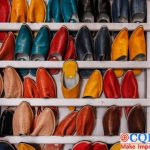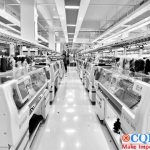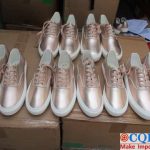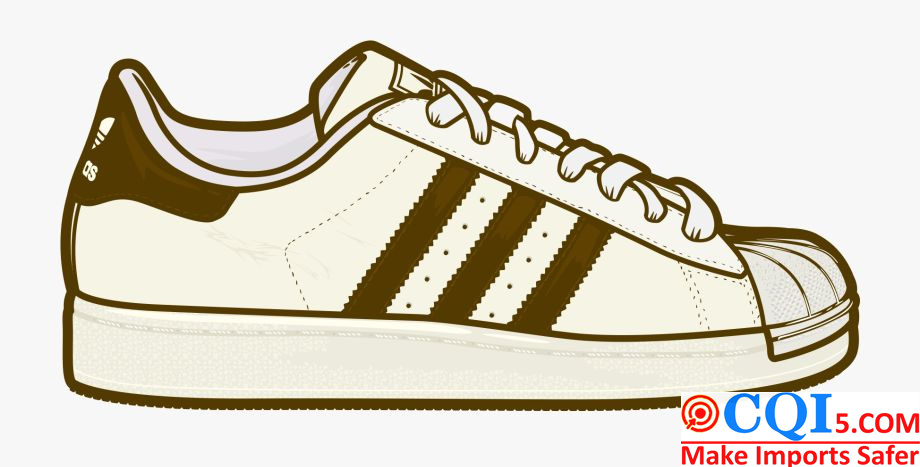Analysis of leather shoes industry Ronald
In the movie “Kingsman: The Secret Service”, Harry picks out leather shoes for Eggsy, and he says something like, “Oxford not Brogue.” Probably all English gentlemen must have a decent pair of leather shoes, just as every girl, at one time or another, secretly tried on the small black pair of high heels that her mother kept in the shoe closet.

Leather shoes industry introduction
Leather shoes are shoes made of natural leather as the upper, leather or rubber, plastic, PU foam, PVC, etc. as the sole, processed and shaped by sewing, gluing or injection molding processes. The upstream industry mainly includes machinery and equipment, raw materials (leather, soles) and other auxiliary materials, etc. The supply and demand, price changes and technical quality level of the products in the upstream industry have certain influence on the development and profitability of the leather shoes industry.
The downstream industry of the leather shoes industry is the leather shoes retail industry which is directly facing the consumers, and the development of the industry is closely related to the purchasing power of consumers. With the rapid development of the economy, the level of disposable income of the residents has been increasing, and the consumption ability, brand awareness and consumption grade have been gradually enhanced, all of which have contributed to the rapid growth of the consumption of middle and high-end leather shoes.
Overview of the International Leather Shoes Industry
1 / International leather shoes industry pattern
With the continuous globalization process, the leather shoes industry has undergone profound changes worldwide. Due to changes in various factors such as land resources, raw materials and labor costs, and sales markets, the global leather shoes manufacturing center shifted from countries such as Italy and Spain in the early years to countries and regions such as Japan, Korea and Taiwan in the 1980s, and gradually to developing countries such as China in the late 1990s where production costs are lower. At present, the leather shoes industry has formed an industry pattern in which European and American leather shoes enterprises are engaged in brand operation, while developing countries’ leather shoes enterprises represented by China are engaged in production and processing.

European and American leather shoes enterprises put brand operation in the first place, focusing on brand value enhancement and market promotion to earn high profits in the industrial chain. Leather shoes enterprises in developing countries, represented by China, mainly rely on the advantages of abundant human resources and low labor costs to undertake international industrial transfer, produce and process shoes for well-known brands in Europe and the United States, and obtain economies of scale in production and processing. In recent years, China’s large leather shoes enterprises have also begun to focus on brand building and have achieved better economic benefits by virtue of their own brand image and channel advantages.
2 / Development trend of international leather shoes industry
In recent years, international well-known leather shoes enterprises have increasingly focused their attention on brand building and marketing network development in their development, aiming to improve their competitiveness in all aspects.
Brand building is the top priority in the development of leather shoes enterprises. Compared with Chinese leather shoes enterprises, most of the well-known brands in Europe and America have a longer history, emphasize brand connotation and characteristics, focus on product design and positioning, and have strong brand building and promotion capabilities. For example, the famous British brand Clarks was founded in 1825, the American HushPuppies was founded in 1958, the Danish ECCO was founded in 1963, and the American NineWest was founded in 1969. These brands have their own unique brand origins, combined with excellent product design and continuous innovation to maintain high brand awareness and market share.
Marketing network construction reflects the core competitiveness of leather shoes enterprises. As the marketing network terminals are directly facing consumers, the breadth and depth of the marketing network is crucial to enhance the visibility of the enterprise brand and increase the market share of the enterprise. In recent years, internationally renowned leather shoes companies have continued to invest in the construction of their marketing networks, especially in the markets of emerging economies to expand the scale of their marketing networks.
Overview of China’s Leather Shoes Industry
1 / Scale and Growth of China’s Leather Shoes Industry
China is the world’s largest consumer market for footwear products, and the consumption volume of footwear in China has been growing steadily in recent years. According to the China Bureau of Statistics, the number of enterprises above the scale of China’s leather footwear manufacturing industry was 2,621 in 2015, with sales revenue of US$70 billion and total annual profit of US$4.7 billion, and the compound annual average growth rate of sales of leather footwear products in China from 2009 to 2014 was 10.6%, with a steady increase in residents’ leather footwear expenditure.
However, compared with developed countries, the leather footwear consumption of Chinese residents is still at a relatively low level. According to the data released in the 2017-2022 China Leather Footwear Manufacturing Market Monitoring and Investment Prospects Research Report, the apparent consumption scale of leather footwear in China was US$462.2 billion in 2015, with leather footwear exports amounting to US$10.5 billion and annual imports amounting to only US$1.4 billion. Measured by the total population of 1.375 billion in 2015, the per capita demand for leather shoes in China is 2.80 pairs, which is much lower than the per capita consumption of the United States and Japan, and the per capita consumption amount is 45 yuan, which is only 1/5 of the level of the United States in 2008.
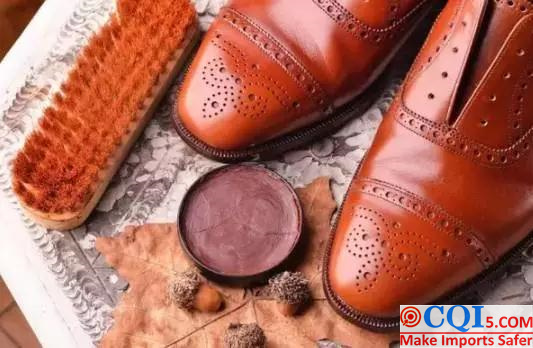
2 / Development characteristics of China’s leather shoes industry
A. Leather shoes production capacity is mainly concentrated in the east, with a trend of shifting to the west
At present, China’s leather shoes production is still concentrated in Fujian, Zhejiang and Guangdong provinces, which accounted for 69.62% of the national total production in 2015, forming a number of industrial clusters such as Wenzhou in Zhejiang, Huidong in Guangdong, Wenling in Zhejiang, Jinjiang in Fujian and Heshan in Guangdong. In addition, Dongguan, Guangdong has a strong footwear industry foundation, while Putian, Fujian, Danyang and Jiangdu, Jiangsu, Gaomi and Lancun, Shandong are also booming.
With the rising cost of various production factors in the east, production capacity, output and investment have begun to gradually shift to the central and western regions, and a number of new footwear industry clusters are gradually forming in the central and western regions, such as Chengdu, Chongqing, Anyue. Through this shift, eastern footwear enterprises are gradually focusing their main resources and efforts on brand promotion, product development and design, and marketing channel construction.
B. Leather shoes enterprises move to a new stage of brand promotion
Since the mid-1990s, Chinese leather shoes enterprises have gone through the process from the beginning to the development and growth, and a large number of independent brand enterprises have stood out and become the backbone of the industry development, with brand awareness and enterprise strength rising rapidly and embarking on the road of branding operation.
From the history of Chinese leather shoes brand development, most Chinese shoes enterprises started from the domestic second and third-tier consumer market, adapting to the domestic low-end market demand, which not only achieved the accumulation of strength and rapid development, but also avoided direct competition with international brands in first-tier cities. With the growth and development of domestic brands, after stabilizing the second and third-tier markets, they continued to march to the first-tier cities, continuously improving their brand image and expanding their brand influence, and achieved remarkable results. In recent years, famous leather shoes enterprises such as Belle International, Saturday, Qianbaidu International and Aokang International have been listed at home and abroad, with the help of the capital market, injecting strong momentum into the development of enterprises, enhancing the brand influence and channel competitiveness, and also elevating the industry competition to a new level.
C. Brand leather shoes enterprise marketing channel construction enters a stable development stage after high-speed expansion
Channel resources have become one of the core competitiveness of branded leather shoes enterprises. Chinese leather shoes brand enterprises all attach great importance to channel construction, constantly seeking high-quality store resources and strengthening the expansion of sales terminals. Affected by the weak consumer market in recent years, Chinese brand shoes enterprises have entered a stable development stage after the rapid expansion in the early stage.
3 / Competitive Landscape of China’s Leather Shoes Industry
The market concentration in China’s footwear industry is low, and competition among brand terminals is fierce. According to the Euromonitor report, Belle International, Daphne International and Red Dragonfly share ranked among the top three in the industry with market shares of 7.4%, 2.9% and 1.4% respectively in 2014. Kang Nai Group ranked 5th in the leather shoes industry in terms of market share with 1%.
CQI5 is committed to providing importers worldwide with product quality inspection services that far exceed those of our peers. If you are planning to import or have imported from China or Southeast Asian countries, please contact us cs’@’cqipro.com to learn more about how we can make your imports safer.
Disclaimer:
CQI5 article information from the Internet and contributions, the copyright of which belongs to the original author, and only represents the views of the original author. This website is only responsible for sorting out, typesetting and editing the articles, reproduced for the purpose of spreading more information, does not imply that it endorses its views or proves the truthfulness, completeness and accuracy of its content, and therefore does not assume any legal responsibility.
The information contained in this article is for reference only and is not intended as direct advice for decision-making.
If we inadvertently violate your copyright, please inform us, after verification, we will immediately correct or delete the content according to the requirements of the copyright holder, thank you! Contact, email: copyright@cqipro.com
This website has the final right to interpret this statement.
Welcome to reprint, please be sure to keep information complete.
